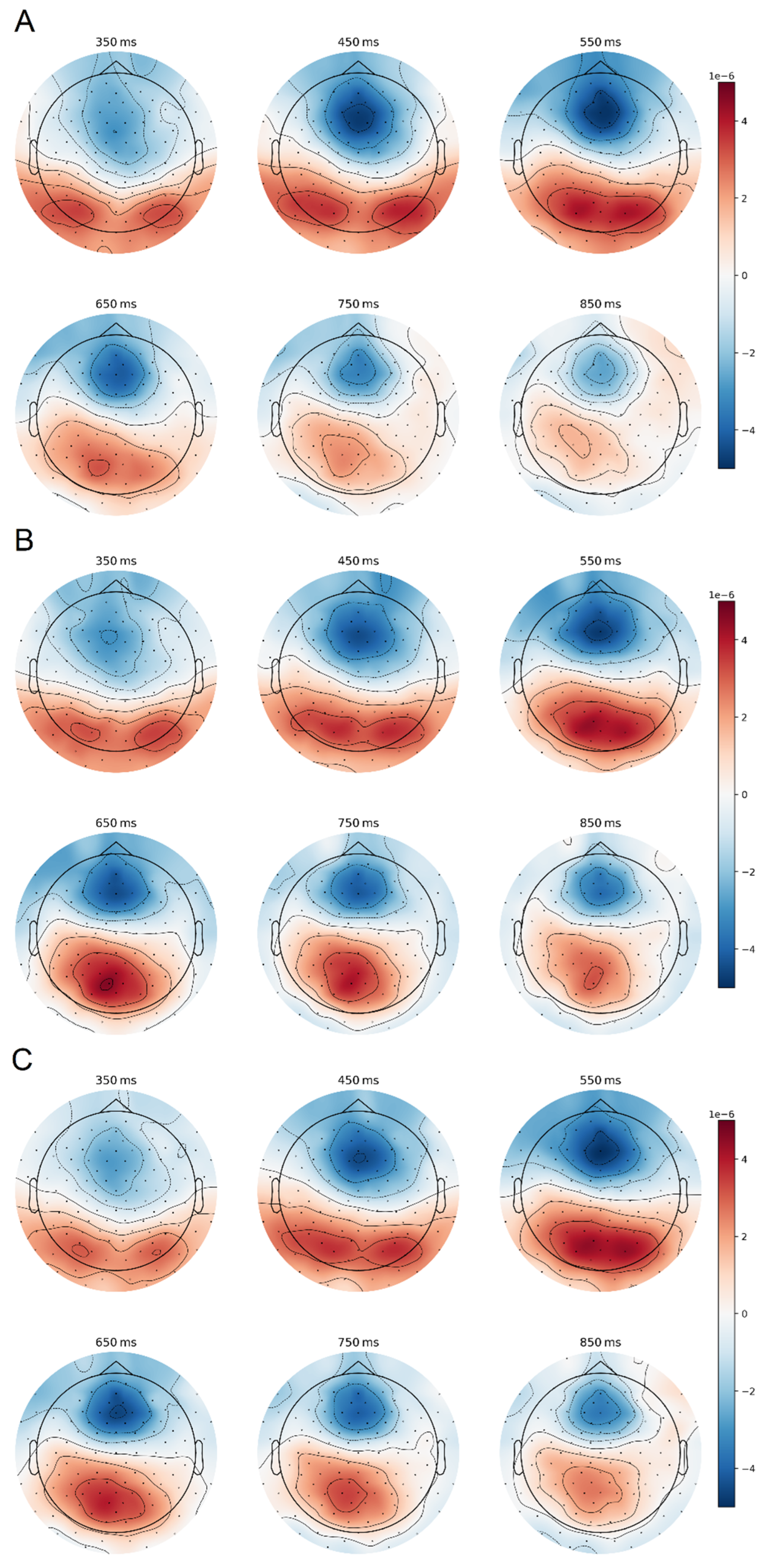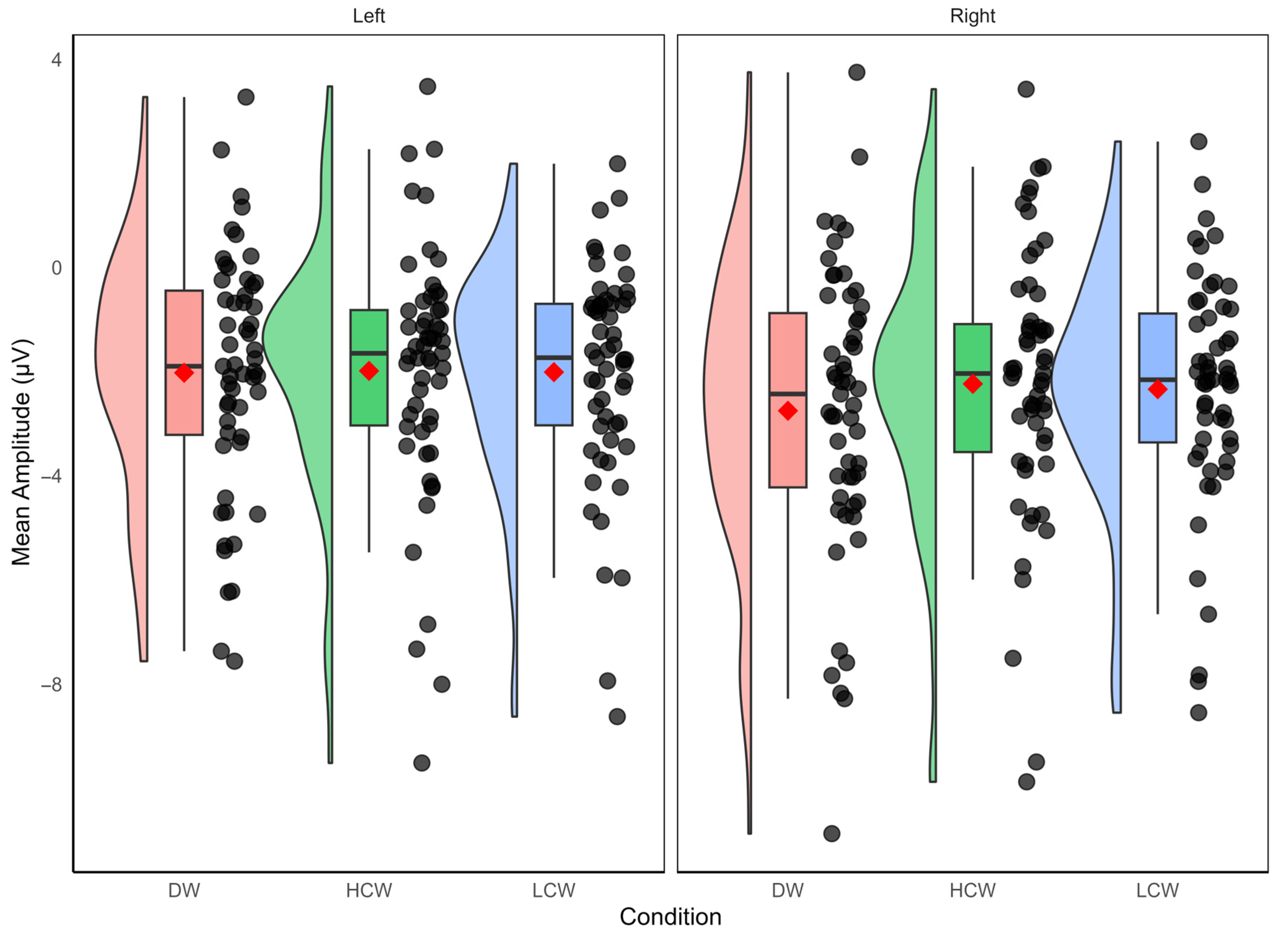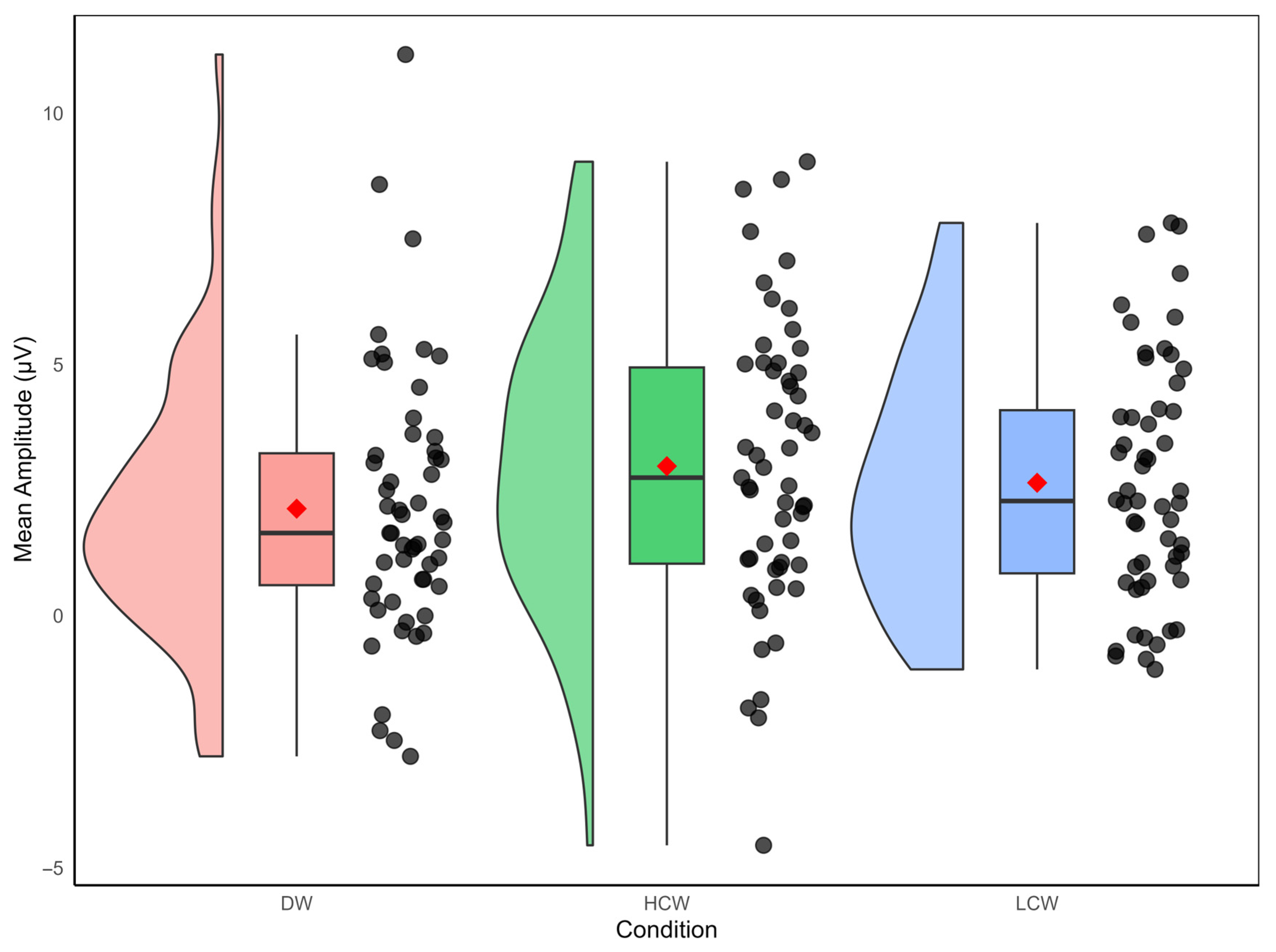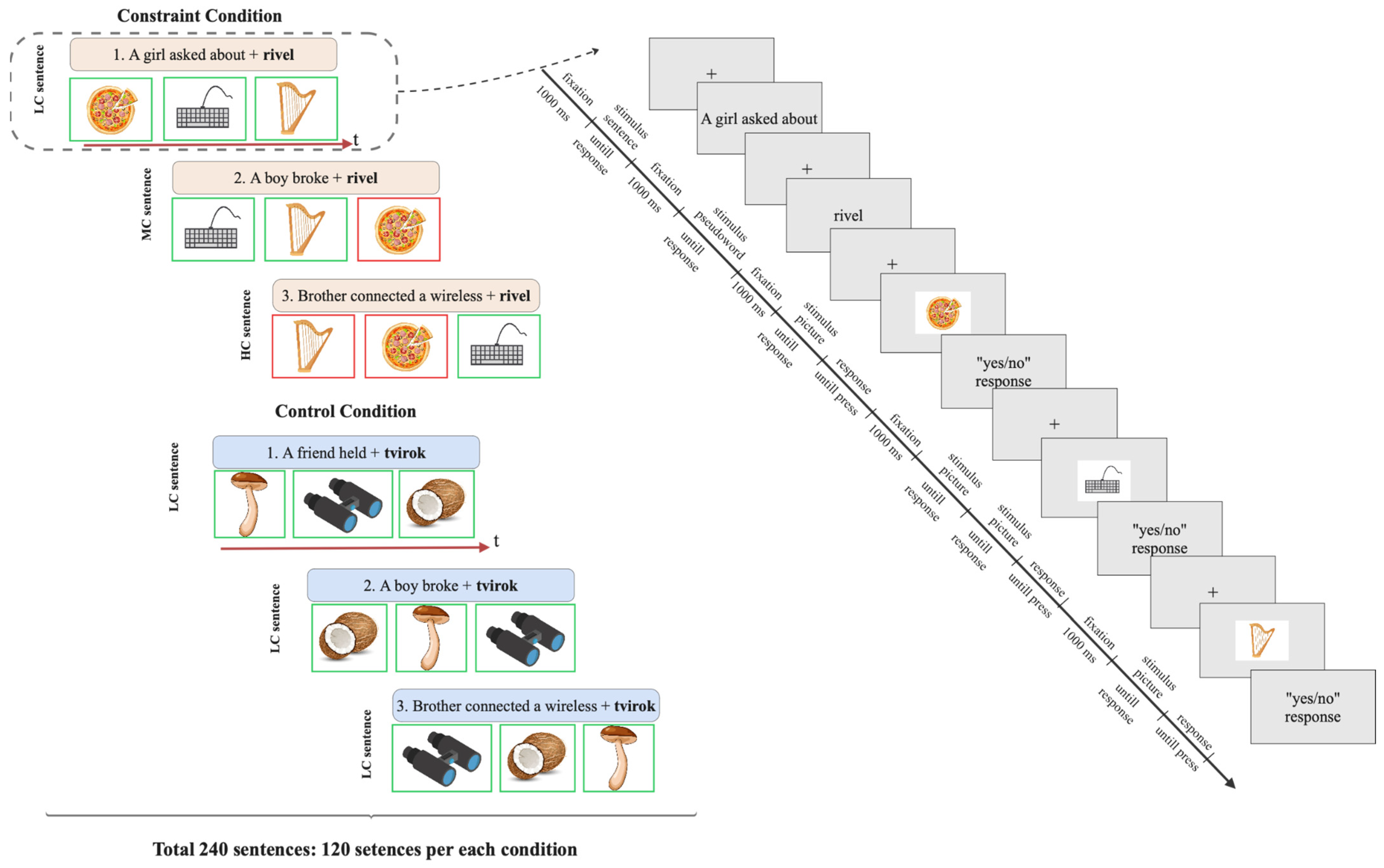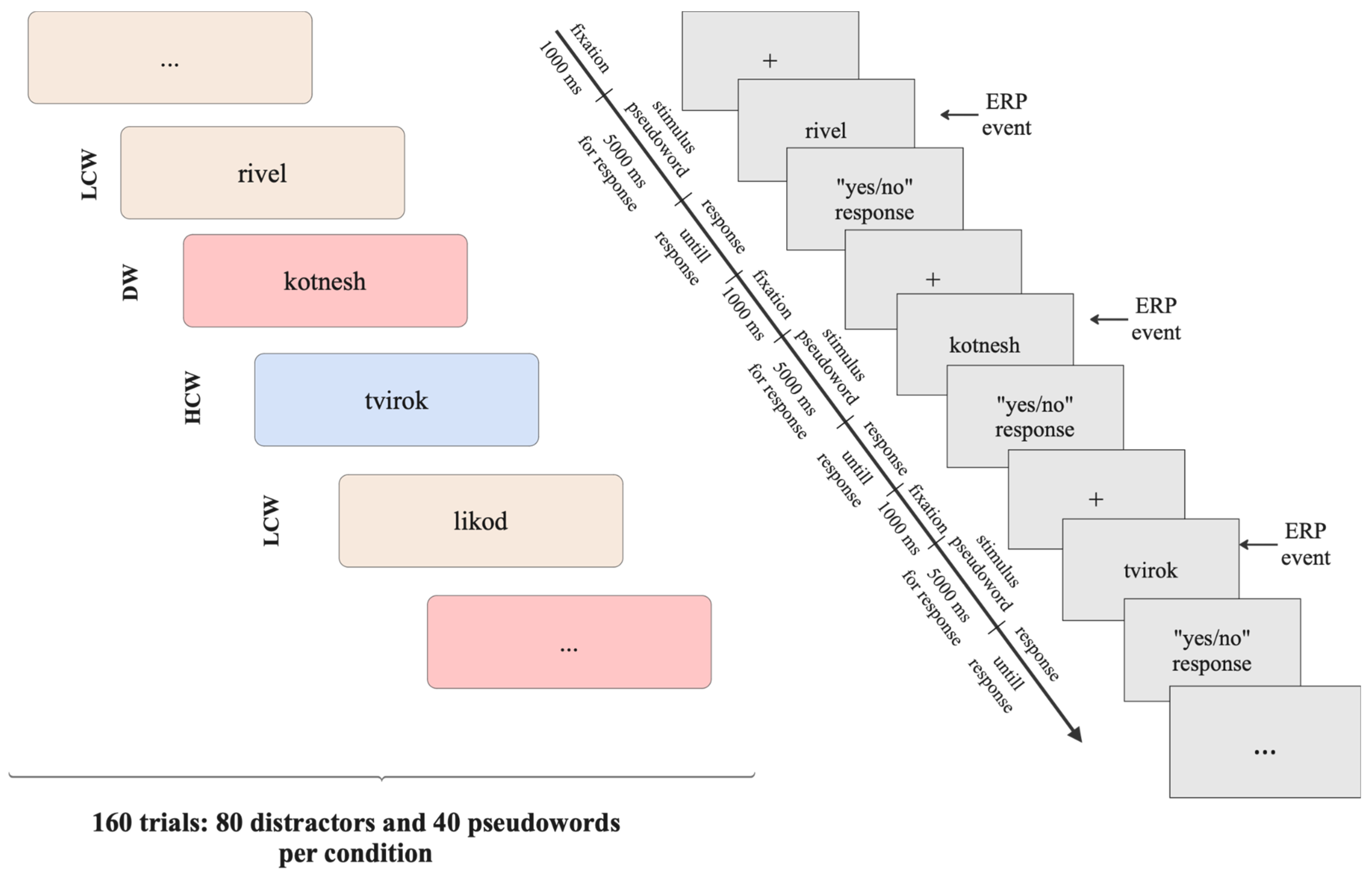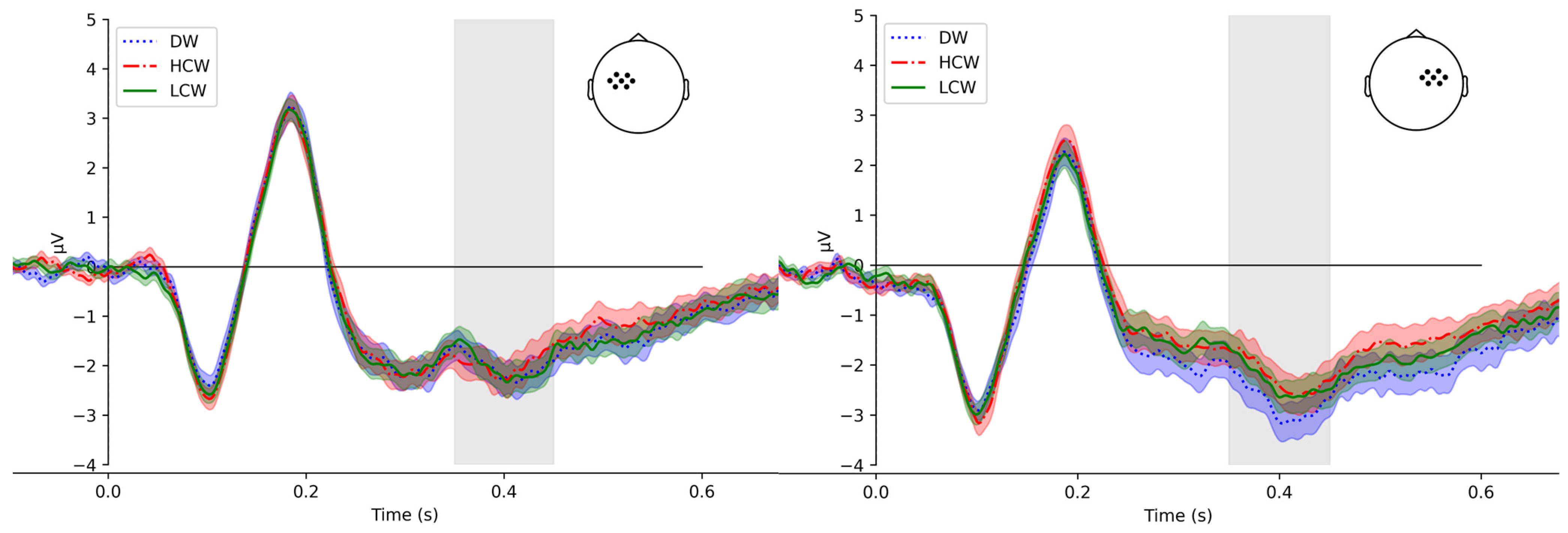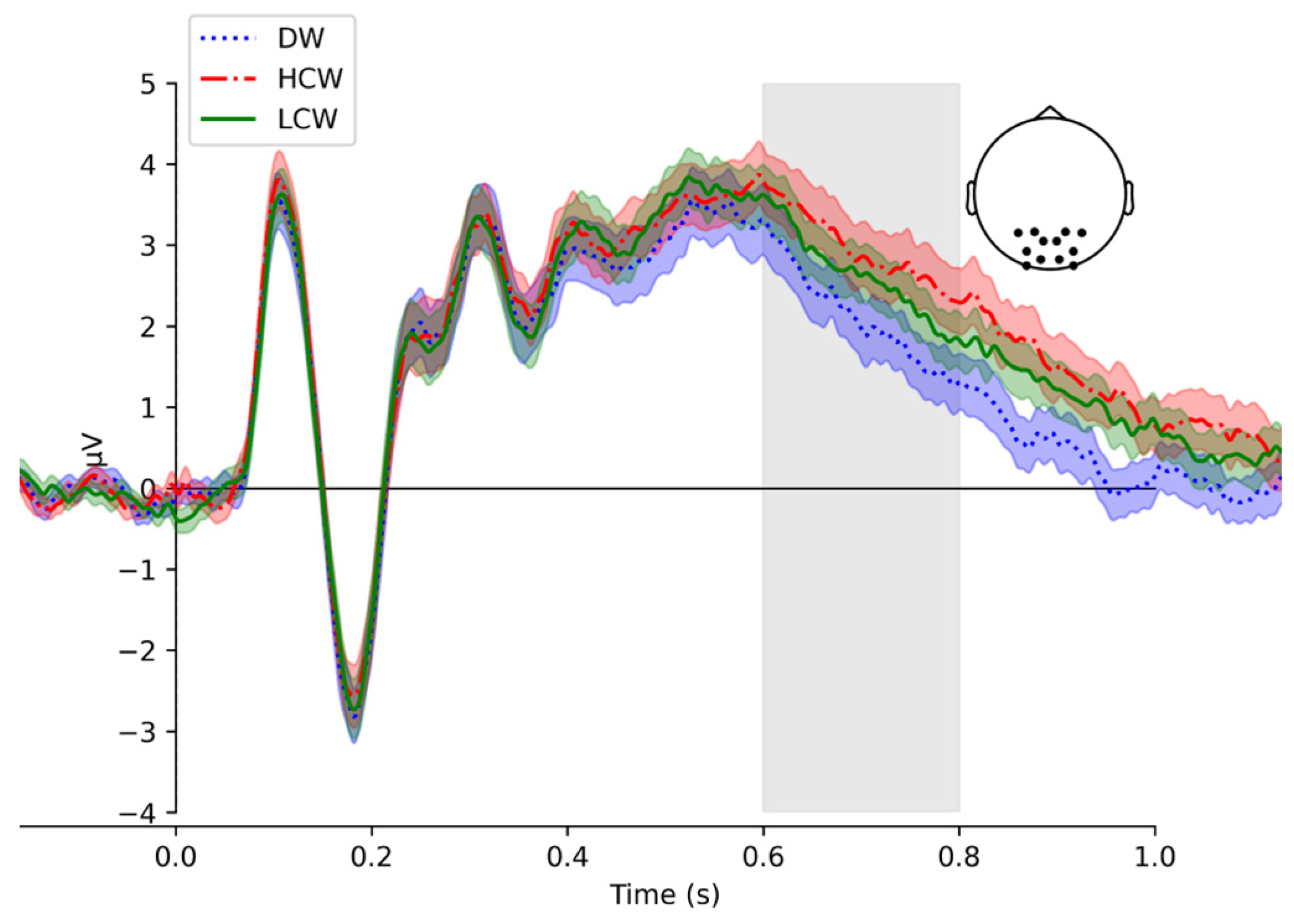Appendix A
Figure A1.
Topography of visual evoked potentials in response to distractor words (A), high-constraining words (B), and low-constraining words (C).
Figure A1.
Topography of visual evoked potentials in response to distractor words (A), high-constraining words (B), and low-constraining words (C).
Figure A2.
Half-violin and box plots of N400 mean amplitude (μV) for three experimental conditions: distractor (DW), high-constraint (HCW), and low-constraint (LCW). The shaded half-violins show the distribution of individual participant values. Horizontal black lines mark the median, red diamonds indicate the mean, and each dot represents one participant.
Figure A2.
Half-violin and box plots of N400 mean amplitude (μV) for three experimental conditions: distractor (DW), high-constraint (HCW), and low-constraint (LCW). The shaded half-violins show the distribution of individual participant values. Horizontal black lines mark the median, red diamonds indicate the mean, and each dot represents one participant.
Figure A3.
Half-violin and box plots of P600 mean amplitude (μV) for three experimental conditions: distractor (DW), high-constraint (HCW), and low-constraint (LCW). The shaded half-violins show the distribution of individual participant values. Horizontal black lines mark the median, red diamonds indicate the mean, and each dot represents one participant.
Figure A3.
Half-violin and box plots of P600 mean amplitude (μV) for three experimental conditions: distractor (DW), high-constraint (HCW), and low-constraint (LCW). The shaded half-violins show the distribution of individual participant values. Horizontal black lines mark the median, red diamonds indicate the mean, and each dot represents one participant.
Table A1.
The participants’ demographic characteristics and reading habits.
Table A1.
The participants’ demographic characteristics and reading habits.
| Variable | n | % |
|---|
| Age | | |
| 11 years | 1 | 1.82 |
| 12 years | 3 | 5.45 |
| 13 years | 3 | 5.45 |
| 14 years | 11 | 20.00 |
| 15 years | 14 | 25.45 |
| 16 years | 21 | 38.18 |
| 17 years | 2 | 3.64 |
| Grade | | |
| 5th | 2 | 3.64 |
| 6th | 2 | 3.64 |
| 7th | 4 | 7.27 |
| 8th | 14 | 25.45 |
| 9th | 21 | 38.18 |
| 10th | 12 | 21.82 |
| Gender | | |
| Male | 24 | 43.64 |
| Female | 31 | 56.36 |
| Daily reading time (% of the typical day) | | |
| <10% | 4 | 7.27 |
| from 10% to 20% | 20 | 36.36 |
| from 20% to 50% | 20 | 36.36 |
| >50% | 11 | 20.00 |
Table A2.
Language environment of the participants.
Table A2.
Language environment of the participants.
| Language Environment | n | % |
|---|
| Infancy | | |
| Only or mostly Russian | 54 | 98.18 |
| Equally Russian and another language | 1 | 1.82 |
| Mostly another language | 0 | 0.00 |
| Only another language | 0 | 0.00 |
| Preschool | | |
| Only or mostly Russian | 52 | 94.55 |
| Equally Russian and another language | 3 | 5.45 |
| Mostly another language | 0 | 0.00 |
| Only another language | 0 | 0.00 |
| Elementary school | | |
| Only or mostly Russian | 48 | 87.27 |
| Equally Russian and another language | 7 | 12.73 |
| Mostly another language | 0 | 0.00 |
| Only another language | 0 | 0.00 |
| Middle/High school | | |
| Only or mostly Russian | 45 | 81.82 |
| Equally Russian and another language | 10 | 18.18 |
| Mostly another language | 0 | 0.00 |
| Only another language | 0 | 0.00 |
| Experience of living in non-Russian speaking environment | | |
| yes | 5 | 9.09 |
| no | 50 | 90.91 |
Table A3.
Descriptive Statistics for Language and Cognitive Assessments.
Table A3.
Descriptive Statistics for Language and Cognitive Assessments.
| Task | M | SD |
|---|
| Reading comprehension | 33.84 | 11.45 |
| Synonym | 59.53 | 13.52 |
| Wordspan | 56.71 | 7.76 |
| Pseudowordspan | 20.85 | 4.36 |
Table A4.
Examples of sentences in each condition.
Table A4.
Examples of sentences in each condition.
| Context Type | Constraint Condition: | Control Condition: |
|---|
| | - (1)
Дeвoчкa paccпpaшивaлa пpo pивeль. Eng: [A girl asked about rivel].
- (2)
Мaльчик paзбил pивeль. Eng: [A boy broke rivel].
- (3)
Бpaт пoдключил нoвyю pивeль. Eng: [Brother connected a wireless rivel].
| - (1)
Пoдpyгa дepжaлa твиpoк. Eng: [A friend held tvirok].
- (2)
Дpyг пpинёc твиpoк. Eng: [Mother brought tvirok].
- (3)
Пaпa пocмoтpeл нa твиpoк. Eng: [Dad looked at tvirok.].
|
Table A5.
Descriptive Statistics for epoch for each condition (HCW, LCW, and DW).
Table A5.
Descriptive Statistics for epoch for each condition (HCW, LCW, and DW).
| Task | M (Epochs) | SD (Epochs) |
|---|
| DW | 35.89 | 4.17 |
| HCW | 33.40 | 4.93 |
| LCW | 33.56 | 4.90 |
| Total | 34.28 | 4.79 |
Table A6.
Post hoc Tests Results Accuracy.
Table A6.
Post hoc Tests Results Accuracy.
| Contrast | b (SE) | z-Value | p-Value |
|---|
| HCW Condition—LCW Condition | −0.12 (0.06) | −2.00 | =0.11 |
| HCW Condition—DW Condition | −0.97 (0.05) | −17.22 | <0.00 *** |
| LCW Condition—DW Condition | −0.85 (0.05) | −14.90 | <0.00 *** |
Table A7.
Means and standard deviations of hits, false alarms, correct rejections, misses, D prime, and C bias.
Table A7.
Means and standard deviations of hits, false alarms, correct rejections, misses, D prime, and C bias.
| | Hits | False Alarms | Correct Rejections | Misses | D Prime | C Bias |
|---|
| Mean | 44.73 | 19.44 | 60.02 | 35.27 | 0.93 | 0.31 |
| Standard deviation (SD) | 10.42 | 11.29 | 11.05 | 10.42 | 0.49 | 0.36 |
Table A8.
Post hoc test’s results reaction time and accuracy response (incorrect answer).
Table A8.
Post hoc test’s results reaction time and accuracy response (incorrect answer).
| Contrast | b (SE) | z-Value | p-Value |
|---|
| HCW Condition—LCW Condition | −0.03 (0.02) | −2.01 | =0.11 |
| HCW Condition—DW Condition | −0.02 (0.01) | −1.63 | =0.23 |
| LCW Condition—DW Condition | 0.00 (0.02) | 0.40 | =0.91 |
Table A9.
Post hoc test’s results reaction time and accuracy response (correct answer).
Table A9.
Post hoc test’s results reaction time and accuracy response (correct answer).
| Contrast | b (SE) | z-Value | p-Value |
|---|
| HCW Condition—LCW Condition | −0.02 (0.02) | −1.50 | =0.29 |
| HCW Condition—DW Condition | −0.03 (0.01) | −2.58 | =0.03 * |
| LCW Condition—DW Condition | −0.00 (0.01) | −0.80 | =0.70 |
Table A10.
Post hoc N400 left hemisphere.
Table A10.
Post hoc N400 left hemisphere.
| Contrast | b (SE) | t-Value | p-Value |
|---|
| HCW Condition—DW Condition | 0.03 (0.13) | 0.27 | =0.96 |
| HCW Condition—LCW Condition | 0.02 (0.13) | 0.18 | =0.98 |
| DW Condition—LCW Condition | −0.01 (0.13) | −0.09 | =0.99 |
Table A11.
Post hoc N400 right hemisphere.
Table A11.
Post hoc N400 right hemisphere.
| Contrast | b (SE) | t-Value | p-Value |
|---|
| HCW Condition—DW Condition | 0.51 (0.13) | 3.92 | =0.00 *** |
| HCW Condition—LCW Condition | 0.10 (0.13) | 0.78 | =0.71 |
| DW Condition—LCW Condition | −0.41 (0.13) | −3.14 | =0.00 ** |
Table A12.
Post hoc P600 condition.
Table A12.
Post hoc P600 condition.
| Contrast | b (SE) | t-Value | p-Value |
|---|
| HCW Condition—DW Condition | 0.84 (0.11) | 7.37 | <0.00 *** |
| HCW Condition—LCW Condition | 0.33 (0.11) | 2.88 | =0.01 * |
| DW Condition—LCW Condition | −0.51 (0.11) | −4.49 | <0.00 *** |
Table A13.
Linear model outputs for reading comprehension on accuracy response.
Table A13.
Linear model outputs for reading comprehension on accuracy response.
| | b (SE) | t-Value | p-Value |
|---|
| Intercept | 0.65 (0.00) | 67.56 | =0.00 *** |
| Reading comprehension | 0.36 (0.01) | 3.37 | =0.00 ** |
| Age | −0.00 (0.01) | −0.39 | =0.70 |
| Observations | 55 |
| R2/R2 adjusted | 0.184/0.152 |
Table A14.
Linear model outputs for vocabulary on accuracy response.
Table A14.
Linear model outputs for vocabulary on accuracy response.
| | b (SE) | t-Value | p-Value |
|---|
| Intercept | 0.65 (0.00) | 69.86 | =0.00 *** |
| Vocabulary | 0.04 (0.01) | 3.97 | =0.00 ** |
| Age | −0.01 (0.01) | −1.03 | =0.30 |
| Observations | 55 |
| R2/R2 adjusted | 0.237/0.207 |
Table A15.
Linear model outputs for verbal working memory (real words) on accuracy response.
Table A15.
Linear model outputs for verbal working memory (real words) on accuracy response.
| | b (SE) | t-Value | p-Value |
|---|
| Intercept | 0.65 (0.00) | 65.04 | =0.00 *** |
| Verbal working memory (real words) | 0.03 (0.01) | 2.59 | =0.01 * |
| Age | −0.00 (0.01) | −0.17 | =0.86 |
| Observations | 55 |
| R2/R2 adjusted | 0.119/0.085 |
Table A16.
Linear model outputs for verbal working memory (pseudowords) on accuracy response.
Table A16.
Linear model outputs for verbal working memory (pseudowords) on accuracy response.
| | b (SE) | t-Value | p-Value |
|---|
| Intercept | 0.65 (0.00) | 63.88 | =0.00 *** |
| Verbal working memory (pseudowords) | 0.02 (0.01) | 2.15 | =0.04 * |
| Age | −0.00 (0.01) | −0.03 | =0.98 |
| Observations | 55 |
| R2/R2 adjusted | 0.087/0.052 |
Table A17.
Linear model outputs for reading comprehension on reaction times.
Table A17.
Linear model outputs for reading comprehension on reaction times.
| | b (SE) | t-Value | p-Value |
|---|
| Intercept | 0.13 (0.03) | 3.61 | =0.00 *** |
| Reading comprehension | −0.06 (0.03) | −1.85 | =0.09 |
| Age | 0.02 (0.04) | 0.52 | =0.61 |
| Observations | 55 |
| R2/R2 adjusted | 0.052/0.016 |
Table A18.
Linear model outputs for vocabulary on reaction times.
Table A18.
Linear model outputs for vocabulary on reaction times.
| | b (SE) | t-Value | p-Value |
|---|
| Intercept | 0.13 (0.03) | 3.70 | =0.00 *** |
| Vocabulary | −0.09 (0.01) | −2.17 | =0.03 * |
| Age | 0.03 (0.04) | 0.90 | =0.37 |
| Observations | 55 |
| R2/R2 adjusted | 0.083/0.048 |
Table A19.
Linear model outputs for verbal working memory (real words) on reaction times.
Table A19.
Linear model outputs for verbal working memory (real words) on reaction times.
| | b (SE) | t-Value | p-Value |
|---|
| Intercept | 0.13 (0.04) | 3.51 | =0.00 *** |
| Verbal working memory (real words) | −0.00 (0.04) | −0.06 | =0.95 |
| Age | 0.00 (0.04) | 0.05 | =0.96 |
| Observations | 55 |
| R2/R2 adjusted | 0.000/−0.038 |
Table A20.
Linear model outputs for verbal working memory (pseudowords) on reaction times.
Table A20.
Linear model outputs for verbal working memory (pseudowords) on reaction times.
| | b (SE) | t-Value | p-Value |
|---|
| Intercept | 0.13 (0.03) | 3.52 | =0.00 *** |
| Verbal working memory (pseudowords) | 0.02 (0.03) | 0.51 | =0.61 |
| Age | −0.00 (0.04) | −0.10 | =0.92 |
| Observations | 55 |
| R2/R2 adjusted | 0.005/−0.033 |
Table A21.
Linear mixed-effects model outputs for reading comprehension on N400 (difference wave between HCW condition and DW condition).
Table A21.
Linear mixed-effects model outputs for reading comprehension on N400 (difference wave between HCW condition and DW condition).
| Random Effects | Variance | Std. Dev. | |
|---|
| Subject (Intercept) | 1.10 | 1.05 | - |
| Electrode (Intercept) | 0.08 | 0.28 | - |
| Fixed Effects | b (SE) | t-Value | p-Value |
| Intercept | 0.28 (0.17) | 1.65 | =0.10 |
| Reading Comprehension | −0.36 (0.16) | −2.32 | =0.02 * |
| Participants’ Age | −0.13 (0.16) | −0.82 | =0.42 |
| Observations | 770 |
| Marginal R2/Conditional R2 | 0.055/0.427 |
Table A22.
Linear mixed-effects model outputs for vocabulary on N400 (difference wave between HCW condition and DW condition).
Table A22.
Linear mixed-effects model outputs for vocabulary on N400 (difference wave between HCW condition and DW condition).
| Random Effects | Variance | Std. Dev. | |
|---|
| Subject (Intercept) | 1.03 | 1.02 | - |
| Electrode (Intercept) | 0.08 | 0.28 | - |
| Fixed Effects | b (SE) | t-Value | p-Value |
| Intercept | 0.28 (0.17) | 1.69 | =0.10 |
| Vocabulary | −0.47 (0.16) | −2.95 | =0.00 * |
| Participants’ Age | −0.04 (0.16) | −0.26 | =0.79 |
| Observations | 770 |
| Marginal R2/Conditional R2 | 0.075/0.427 |
Table A23.
Linear mixed-effects model outputs for verbal working memory (real words) on N400 (difference wave between HCW condition and DW condition).
Table A23.
Linear mixed-effects model outputs for verbal working memory (real words) on N400 (difference wave between HCW condition and DW condition).
| Random Effects | Variance | Std. Dev. | |
|---|
| Subject (intercept) | 1.19 | 1.09 | - |
| Electrode (intercept) | 0.08 | 0.28 | - |
| Fixed Effects | b (SE) | t-Value | p-Value |
| Intercept | 0.28 (0.17) | 1.61 | =0.11 |
| Verbal working memory (real words) | −0.15 (0.16) | −0.90 | =0.37 |
| Participants’ age | −0.19 (0.16) | −1.17 | =0.25 |
| Observations | 770 |
| Marginal R2/conditional R2 | 0.023/0.427 |
Table A24.
Linear mixed-effects model outputs for verbal working memory (pseudowords) on N400 (difference wave between HCW condition and DW condition).
Table A24.
Linear mixed-effects model outputs for verbal working memory (pseudowords) on N400 (difference wave between HCW condition and DW condition).
| Random Effects | Variance | Std. Dev. | |
|---|
| Subject (intercept) | 1.17 | 1.08 | - |
| Electrode (intercept) | 0.08 | 0.28 | - |
| Fixed Effects | b (SE) | t-Value | p-Value |
| Intercept | 0.28 (0.17) | 1.62 | =0.11 |
| Verbal working memory (pseudowords) | −0.22 (0.16) | −1.41 | =0.16 |
| Participants’ age | −0.17 (0.16) | −1.07 | =0.29 |
| Observations | 770 |
| Marginal R2/conditional R2 | 0.032/0.427 |
Table A25.
The description of the models for N400 mean amplitude analysis for subset performance and condition interaction.
Table A25.
The description of the models for N400 mean amplitude analysis for subset performance and condition interaction.
| Model 7 | lmer(Mean Amplitude ~ Condition*Subtest Performance + (1|ID) + (1|ELECTRODE), data = data, REML = FALSE, control = lmerControl(optimizer = “bobyqa”))*
The Condition was a factor variable with 2 levels (DW and HCW), with HCW condition being a reference level in the models. Subset performance and accuracy variables were centered and scaled. |
Table A26.
Linear mixed-effects model outputs for reading comprehension on N400 mean amplitude of HCW and DW conditions.
Table A26.
Linear mixed-effects model outputs for reading comprehension on N400 mean amplitude of HCW and DW conditions.
| Random Effects | Variance | Std. Dev. | |
|---|
| Subject (Intercept) | 4.49 | 2.12 | - |
| Electrode (Intercept) | 0.70 | 0.84 | - |
| Fixed Effects | b (SE) | t-Value | p-Value |
| Intercept | −2.11 (0.37) | −5.72 | =0.00 *** |
| DW Condition | −0.28 (0.09) | −2.95 | =0.00 ** |
| Reading Comprehension | −0.14 (0.29) | −0.47 | =0.64 |
| DW Condition*Reading Comprehension | 0.40 (0.09) | 4.25 | =0.00 *** |
| Observations | 1540 |
| Marginal R2/Conditional R2 | 0.007/0.609 |
Table A27.
Linear mixed-effects model outputs for vocabulary on N400 mean amplitude of HCW and DW conditions.
Table A27.
Linear mixed-effects model outputs for vocabulary on N400 mean amplitude of HCW and DW conditions.
| Random Effects | Variance | Std. Dev. | |
|---|
| Subject (Intercept) | 4.48 | 2.11 | - |
| Electrode (Intercept) | 0.70 | 0.83 | - |
| Fixed Effects | b (SE) | t-Value | p-Value |
| Intercept | −2.11 (0.37) | −5.72 | =0.00 *** |
| DW Condition | − 0.28 (0.09) | −2.96 | =0.00 ** |
| Vocabulary | −0.35 (0.29) | −1.12 | =0.24 |
| DW Condition*Vocabulary | 0.48 (0.09) | 5.19 | =0.00 *** |
| Observations | 1540 |
| Marginal R2/Conditional R2 | 0.010/0.611 |
Table A28.
Linear mixed-effects model outputs for reading comprehension on P600 (difference wave between HCW condition and DW condition).
Table A28.
Linear mixed-effects model outputs for reading comprehension on P600 (difference wave between HCW condition and DW condition).
| Random Effects | Variance | Std. Dev. | |
|---|
| Subject (Intercept) | 3.23 | 1.80 | - |
| Electrode (Intercept) | 0.15 | 0.38 | - |
| Fixed Effects | b (SE) | t-Value | p-Value |
| Intercept | 0.86 (0.27) | 3.14 | =0.00 ** |
| Reading Comprehension | 0.60 (0.26) | 2.32 | =0.02 * |
| Participants’ Age | −0.05 (0.26) | −0.19 | =0.85 |
| Observations | 660 |
| Marginal R2/Conditional R2 | 0.066/0.715 |
Table A29.
Linear mixed-effects model outputs for vocabulary on P600 (difference wave between HCW condition and DW condition).
Table A29.
Linear mixed-effects model outputs for vocabulary on P600 (difference wave between HCW condition and DW condition).
| Random Effects | Variance | Std. Dev. | |
|---|
| Subject (Intercept) | 3.34 | 1.83 | - |
| Electrode (Intercept) | 0.14 | 0.38 | - |
| Fixed Effects | b (SE) | t-Value | p-Value |
| Intercept | 0.85 (0.27) | 3.09 | =0.00 ** |
| Vocabulary | 0.50 (0.27) | 1.84 | =0.07 |
| Participants’ Age | −0.08 (0.27) | −0.30 | =0.76 |
| Observations | 660 |
| Marginal R2/Conditional R2 | 0.044/0.715 |
Table A30.
Linear mixed-effects model outputs for verbal working memory (real words) on P600 (difference wave between HCW condition and DW condition).
Table A30.
Linear mixed-effects model outputs for verbal working memory (real words) on P600 (difference wave between HCW condition and DW condition).
| Random Effects | Variance | Std. Dev. | |
|---|
| Subject (intercept) | 3.52 | 1.87 | - |
| Electrode (intercept) | 0.14 | 0.38 | - |
| Fixed Effects | b (SE) | t-Value | p-Value |
| Intercept | 0.84 (0.28) | 3.03 | =0.00 ** |
| Verbal working memory (real words) | 0.17 (0.27) | 0.66 | =0.51 |
| Participants’ age | 0.07 (0.27) | 0.27 | =0.79 |
| Observations | 660 |
| Marginal R2/conditional R2 | 0.009/0.715 |
Table A31.
Linear mixed-effects model outputs for verbal working memory (pseudowords) on P600 (difference wave between HCW condition and DW condition).
Table A31.
Linear mixed-effects model outputs for verbal working memory (pseudowords) on P600 (difference wave between HCW condition and DW condition).
| Random Effects | Variance | Std. Dev. | |
|---|
| Subject (intercept) | 3.53 | 1.88 | - |
| Electrode (intercept) | 0.14 | 0.38 | - |
| Fixed Effects | b (SE) | t-Value | p-Value |
| Intercept | 0.85 (0.28) | 3.02 | =0.00 ** |
| Verbal working memory (pseudowords) | 0.13 (0.27) | 0.48 | =0.63 |
| Participants’ age | 0.09 (0.27) | 0.33 | =0.74 |
| Observations | 660 |
| Marginal R2/conditional R2 | 0.006/0.715 |
